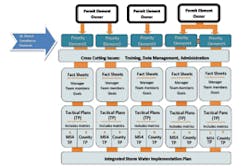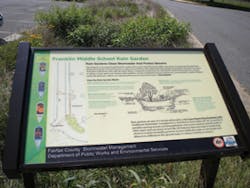Establishing a Culture of Interagency Coordination
Are you the one who’s been tapped to implement the requirements of your increasingly complex municipal separate storm sewer system (MS4) permit? Are you struggling to get the fire marshal to rally in support of your industrial inspection program? Do you need your health inspectors to assist in identifying potential illicit discharges? And what about the street maintenance operation: looking for assistance in reducing the impacts of snow and ice treatment on local roadways? It is not unusual to hear from stormwater program staff who must track and report on permit compliance that the cooperation and support needed throughout their organization is not as effective as it could be. With an increased focus on enforcement from regulators and expanding complexity in permit requirements, local government stormwater managers need an effective strategy for engaging all of the operational units within their government to build a strong management program for their MS4 permit implementation.
To help fill this need, we have developed a comprehensive strategy to assist you in expanding that organizational commitment and support while achieving the long-term goals of your permit. The strategy requires leadership to voice the commitment; engaged staff that can envision what success will look like; a process that will educate, engage, and build teams; and tools to support long-term management goals.
In anticipation of permit renewal, Fairfax County, VA, recently embarked on a journey to expand organizational ownership of its evolving Phase I MS4 permit programs, using a deliberate, tactical planning approach. Fairfax County’s experience has transformed the level of engagement across the entire organization. Collaboration has achieved adoption of best practices that apply in different operational settings while maintaining focus on protecting water resources within the county. The pathway to increased cooperation and engagement has been built on a foundation of leadership that set the strategy in motion. Coupled with a vision of success and a process to achieve it, the strategy has already paid big benefits. The county has developed an effective team structure and a sound tactical planning process that now clearly sets out responsibilities and expectations to meet the requirements anticipated under the new permit and has a framework established for ongoing interagency cooperation.
As MS4 permits throughout the country are being renewed, requirements are increasing in breadth and complexity, resulting in the need for expanding organizational teams to support the compliance effort. Recently reissued Phase I permits, like those in Washington, DC; Montgomery County, MD; and Portland, OR, have included requirements for restoration of a percentage of currently untreated impervious area (some with specific retrofit square-footage targets); development of total maximum daily load (TMDL) implementation plans for pollutants as diverse as nitrogen, trash, and “flow” itself; stepped-up monitoring programs; and even specific tree-planting requirements. These enhanced requirements have introduced additional complexity into management of MS4 programs and now require new skills that need to complement the typical stormwater planner’s or engineer’s experience. Phase II MS4 permittees are also starting to see similar changes to their general permits with specific requirements for monitoring and TMDL implementation plans.
A Tactical Approach to Managing Your MS4 Permit
The Challenge. In discussions with MS4 permit holders, it has become increasingly evident that the approach to managing MS4 programs has to evolve along with the permit itself. The Phase I permit program is now mature, having been in place since the early 1990s, and many communities have established processes for how it is managed and who does the bulk of the work. Stormwater programs, including permit compliance, are typically managed by a designated stormwater engineer or stormwater team in a public works, planning, or environmental services department. As permit compliance has expanded from system inventories, good housekeeping, and public outreach activities to include more robust water-quality protections that focus on identifying and eliminating illicit discharges, enforcing best management practice (BMP) maintenance requirements, designing “green” stormwater controls, and developing nutrient management plans, the skills and experience needed to coordinate and implement the stormwater compliance program have also expanded.
Complicating the issue further is the fact that the extent of expanding requirements continues to reach across a multitude of local government services and agencies–wastewater, solid waste, public health, fire and rescue, parks and recreation, information technology–all of which may play a role in managing compliance programs to reduce the impacts from stormwater runoff. Historic concentration of MS4 management responsibilities in one operation often resulted in the stormwater compliance manager being seen as the sole party responsible for the permit. There is often limited interaction with other operations that may see their only role as contributing information once a year for inclusion in the annual report on activities they carry out in their normal daily routines. These operating units have different missions with their own priorities and budgetary constraints that impact how they view and approach MS4 permit requirements, and they are often not fully aware of how their activities relate to stormwater management and MS4 goals. Successful permit program compliance, defined in terms of efficiency and effectiveness in reducing pollutants in stormwater runoff, requires the permit manager to better educate these other team members on how the permit applies to the entire jurisdiction and to make them realize that their activities play a key role in meeting the terms of the permit. You can’t expect buy-in to the program if staff haven’t been involved in discussions on compliance requirements and haven’t had a say in how their operations will support the fulfilling of permit commitments. Involving all affected agency representatives early in the process, during program planning, is an important step in effective permit management.
It takes leadership and a strong belief in the role of local government in water-quality protection to visualize
and then act on developing a comprehensive team approach focused on permit compliance. It requires a commitment of time and resources to set in motion a process that supports engaging and educating staff and managers across operational lines on permit goals, metrics, and their role in meeting MS4 requirements. With local budgets facing continued pressures as we struggle to recover from the recession, the process used to establish the team has to be efficient and cost-effective. The level of success in implementing a stormwater management program depends on all affected departments and agencies understanding and promoting a culture that makes stormwater management a priority in all aspects of their work. Stormwater management needs to be recognized as complementing existing processes, and not seen as an added burden or distraction.
Case Study: Developing an Inclusive Stormwater Management Plan in Fairfax County, VA
Fairfax County, VA, is a 400-square-mile county just west of Washington, DC, with a population over one million. The county has more than 10,000 employees and a $4 billion annual operating budget; the complexities and extensive service area of the organization itself create challenges for permit management. The county applied for its first MS4 Phase I permit in 1992 and is currently in its second permit cycle. The county has been operating since 2007 under an administratively continued Phase I permit. As with many other communities in the Mid-Atlantic area, the county is expecting a new permit sometime in 2012. Based on preliminary draft permit language provided in 2011, it is anticipated that the permit will include many new or expanded requirements driven in part by the adoption of several local TMDLs, including the Chesapeake Bay TMDL, and the revision of the Virginia Stormwater Management regulations. It is also proposed that the county’s new permit incorporate compliance activities for Fairfax County Public Schools, which currently has its own Phase II MS4 permit.
The primary responsibility for permit coordination and reporting resides in the Department of Public Works and Environmental Services (DPWES), Stormwater Planning Division (SWPD). AMEC’s Environment & Infrastructure business has been working with DPWES, supporting its MS4 program for several years. AMEC and SWPD staff recognized that, while considering the potential impacts of new requirements on county operations, effectively managing the new permit will require additional support not only from other divisions within DPWES but also from outside agencies as diverse as Fairfax County Public Schools, the Park Authority, Facilities Management, Fire and Rescue, and the Health Department.
Under the leadership of the county director of DPWES, James Patteson, a strategy was developed to ensure that no longer would the primary responsibility for compliance fall to a small group of staff within SWPD, but that a coordinated, cross-organizational team would be built that understood the permit requirements and would incorporate stormwater management into their daily operations. Using the preliminary draft permit language from 2011 as a guide, the county decided that it needed to start early to build the team that will take ownership for compliance under the new permit.
So the question was raised–What strategy could be implemented that would result in a practical, operational, countywide stormwater management team? It was determined that the following key items needed to be addressed:
- Outreach to county leadership beyond DPWES to make sure they understood that the permit involved implementation activities beyond the stormwater group and that failure to comply with the permit requirements was unacceptable
- Identification of key agencies and staff to be involved in the planning and execution of the stormwater compliance plan
- Development of a planning process that would provide a consistent framework and guidelines for compliance actions
Through a traditional brainstorming session, staff from SWPD and AMEC developed an outline of a tactical strategy that would meet the goals. The planning process includes five key components:
- DPWES leadership would approach their peers at other county agencies to get buy-in at the management level for the creation of a countywide permit compliance team.
- The draft permit requirements would be grouped into manageable, related elements, and team leaders for each element would be identified.
- For each permit element, tactical plan teams with representatives from all affected departments and agencies would be established.
- Tools, such as fact sheets and tactical plan templates, would be developed to provide guidance to the teams.
- A set of facilitated meetings with the teams would be held to identify the tactics and resources needed to meet the anticipated new permit conditions, including identification of who would lead the implementation of each tactic and the schedule for completion.
The Tactical Planning Process
The first step in the process was to engage the county leadership in an MS4 outreach effort, because it was deemed critical that the tactical planning process used in the county address education and communication issues related to the MS4 permit program. Through a series of briefings, with the objective to educate agency leaders about the permit goals (improvement of water quality) and the repercussions of a failure to comply with the permit (fines and penalties), a broad-based understanding of the permit challenges was achieved. A primary focus of the education message was that compliance with the permit is not the responsibility of one person or agency but the responsibility of the entire county. All levels of county leadership were encouraged to support interagency MS4 teams that would guide permit compliance through development and implementation of tactical plans that would address each agency’s needs while establishing best practices for the entire county organization.
Another component of MS4 compliance identified as key to success was clarifying the roles and responsibilities of the stormwater permit program leadership. It was decided that coordination of the MS4 compliance activities would still be led by experienced staff members from SWPD (designated MS4 coordinators), but now they would have essential support from team leaders for each of the key permit elements, working in turn with key stakeholders from affected agencies and departments. The MS4 coordinators set priorities for the teams, provide guidance on interpretations of permit language or intent, and facilitate permit annual reporting.
Eating the Elephant One Bite at a Time
While debating the best way to manage the expected new MS4 permit requirements and explain them to others in a concise and effective manner, it was determined that the permit elements would be prioritized and grouped into functional categories. Once the permit categories were set, it became easier to identify agencies affected by or influencing that element, as well as the skills and resources needed for compliance with each element. Fairfax County’s MS4 permit is organized around 18 major elements outlined in the 2011 preliminary draft permit:
- Watershed management
- Structural and source controls
- Areas of new and redevelopment
- Roadways
- County facilities
- TMDL action plans
- Retrofitting
- Spill prevention and response
- Pesticide, herbicide, and fertilizer application
- Illicit discharges and improper disposal
- Construction-site runoff
- Monitoring programs
- Public education
- Industrial and high-risk runoff
- Storm sewer infrastructure management
- Water-quality screening programs
- Training
- Tracking and reporting
A team leader for each permit element was identified to direct an interagency team charged with planning for the transition from existing to new permit requirements for that element. County employees across a wide spectrum of operations are involved in stormwater planning, compliance, and maintenance activities that play an important role in implementing permit-related programs within their respective agencies. The Park Authority, for instance, has facility managers, turf managers, and maintenance crews that maintain rain gardens, prepare nutrient management plans, and address winter weather impacts in parking areas. The pool for selecting team leaders was extensive. The ability to take on work above and beyond normal duties and to provide leadership to co-workers in reaching consensus on how each permit element should be managed were key considerations in selecting effective team leaders.
Tools for Success
Fact sheets were developed for each of the 18 permit elements to provide key information so that all group members started with a common understanding. The fact sheets included information such as the existing and proposed preliminary permit language related to the element, current compliance activities, key challenges for implementing new requirements, timing issues, resources and tools needed for implementation, reporting requirements, and links to additional reference information such as the Clean Water Act and state stormwater regulations.
A tactical plan template was then developed to guide the planning process for each element and provide a consistent structure for development of actions, definition of resources, and identification of potential impacts on other permit tactical teams. The template identified the key items (including examples of the level of detail needed) to be included in each tactical plan. These items included:
- the goals of the plan;
- a gaps analysis, with a description of the current program and identification of gaps to meet anticipated new requirements;
- identification of action items, such as development of standard operating procedures, assignment of agency leads, and timing of implementation;
- deliverables resulting from the tactical plan; and
- resource, training, and information technology needs.
The tactical teams used a process of face-to-face meetings (with take-home assignments in between) for the gathering of data, discussion of best practices, identification of strategies, and development of recommendations on county-specific approaches. Team members were initially provided a questionnaire that gathered information about their agency’s current activities related to the permit element. AMEC assisted by providing analyses of the questionnaires and county data to summarize current activities and identify potential gaps in meeting anticipated new permit requirements. Once each team fully considered potential gaps and current permit strategies, and reviewed research on best management practices for compliance, each team defined actions, timelines, and resource needs for both short-term and long-range planning. Each of the county agencies involved reviewed a draft tactical plan before the plan was finalized. Recognizing that it might be beneficial to implement some actions before the renewal permit was issued, the county prioritized the tactical plan recommendations and began implementation of the highest priorities immediately.
The Pilot Plan
Before tackling the planning process with all 18 permit teams, a pilot tactical plan study was conducted for the Roadways permit element to ground-truth the process. Roadways compliance in Fairfax County is somewhat unique for a Phase I community as the Virginia Department of Transportation (VDOT), not the county, provides maintenance and operation of the majority of the road system, and VDOT holds its own Phase II MS4 permit. The county’s responsibility for Roadways under the MS4 permit applies primarily to county-maintained parking lots and a limited number of road segments. Since the Roadways compliance efforts would be applicable to specific, limited county sites but also involve several county agencies, this permit element was selected for use in a pilot study to evaluate the proposed tactical planning process and fine-tune it as necessary.
The Roadways tactical plan team was led by the county’s Maintenance and Stormwater Management Division and included representatives from SWPD, Public Schools, Facilities Management, Solid Waste, Wastewater, and Housing and Community Development. The Roadways permit requirements were segmented into categories related to good housekeeping and pollution prevention practices; evaluation of sweeping practices; and management of deicing activities, cleanup, and materials storage. Action items under each of these categories were developed and prioritized based on the implementation timeframe outlined in the MS4 permit. One action item specifically addressed the establishment of a best practice approach for the winter weather management and maintenance program. The Fairfax County Schools maintenance strategy already in place was recognized as an effective model for managing snow removal and protecting storm drain inlets for other county operations.
Sharing knowledge and plans has been extremely beneficial in terms of establishing best practices that will serve all areas of county operations once new permit requirements are in place. Based on lessons learned from the pilot study, the tactical plan template was revised to include an executive summary that team members could provide to their agency’s management, and the planning process itself was expanded to provide more context and information about related best practices being employed in other communities.
Implementing the Full-Scale Tactical Planning Process
Based on the feedback from the Roadways pilot, the tactical planning process was modified to combine related permit elements together to increase efficiencies and coordination. Following completion of the Roadways pilot study, work began on tactical plans for five additional permit elements, which were organized into three teams and run in parallel. The team assignments were:
- Team 1: Illicit Discharge and Improper Disposal and Spill Response
- Team 2: Industrial and High-Risk Runoff
- Team 3: Water-Quality Screening and Monitoring
The three teams developed tactical plans using a similar step-by-step process and meeting schedule as implemented in the Roadways pilot study. Over a 10-week period, team members identified program gaps, were provided information about the types of best management practices used in other communities to address similar requirements, and established tactics needed to fill the gaps. Some individuals, because of their organizational responsibilities, served on multiple teams, and this aided in identifying overlaps in actions from various tactical plans that can be addressed in a coordinated manner. The action items from all five tactical plans were then grouped to address similar issues more efficiently. The result is a specific set of tactics focused on activities that enhance existing processes and procedures.
Conclusions
The tactical planning process is still ongoing, but preliminary results show that the process has reinforced the organizational commitment to ensuring effective permit compliance in Fairfax County and that staff charged with permit management and oversight now have more knowledgeable teams to support their efforts. The MS4 coordinators who previously were responsible for the details of program development, implementation, tracking, and reporting across all permit elements now have support from a cadre of permit element experts. The permit element teams have brought together staff from multiple county agencies to learn more about the MS4 permit and how important their work is in permit compliance. Many of the staff from outside of DPWES have become engaged in moving the program forward and have provided important input about how their activities can contribute to increased protection of water quality.
The planning process has facilitated discussions among team members about how activities related to stormwater management are conducted across the county, resulting in sharing of knowledge about best practices, data tracking, and standard operating procedures. The process has already resulted in identification and scheduling of specific tactics for six of the county’s 18 permit categories. These tactics were developed by interagency teams and will be implemented by interagency personnel. The tactical planning process has established MS4 program buy-in and awareness for permit element team leaders and team members.
The permit element teams have begun to address the high-priority action items identified in their tactical plans. As an example, the Roadways team has been holding quarterly meetings to address action items identified in its tactical plan. The first action item was development of a standard operating procedure for snow operations. Through team discussions, it was determined that the agencies responsible for snow removal (Maintenance and Stormwater Management, Public Schools, Park Authority, Solid Waste, and Housing and Community Development) were operating independently but using similar procedures. The agencies collaborated on a snow operations standard operating procedure that can now be used by all agencies in training county snow removal operators and contractors. The Roadways team plans to address issues related to deicing material storage and the sweeping program next.
The tactical plans are intended to be dynamic, living documents that will serve as guides for the future and will be used to update the county’s Stormwater Management Program Plan, a requirement of the MS4 permit. The plans will assist in developing resource analysis and budgets for the future. They will ensure consistency in permit compliance, regardless of organizational unit responsibility, over the five-year permit term. New energy and teamwork arising out of the tactical planning process has been focused on ensuring that water-quality protection is a consideration in all services provided to the citizens and to the business community in Fairfax County. Through this tactical planning process, the county has taken a significant step forward in establishing a culture that supports a countywide approach to implementation of its stormwater management program.



